Digital communities are still a thing
Thoughts on digital communities, the rise of communities in 2020, digital community framework, and the challenges.
December 2011 - I had completed a year of running Lighthouse Insights.
A year of working hard and trying to prove my best in Marketing & Advertising. An industry that didn’t give a fuck to social media marketing. Brand managers and agency leaders would joke and say digital is just a one night stand.
Social media marketing was scratching the surface in India. Most brands were doing Facebook marketing with the help of Facebook Apps. During this time we had reviewed a campaign from Britannia called “The Hunt for the True Snexy – India’s First Reality Snack show.”
The campaign had a social media presence, an active blog, and a microsite. Additionally, the campaign had multiple Facebook pages to demonstrate every flavor launched by the brand.
All this was being done in 2011. I found it interesting and decided to interview Sandip Maiti. This was my first interaction with the CEO of Experience Commerce.
Over the years I have been blessed to listen to his thoughts, cover almost all his agency’s work, interview him multiple times, and had been a great supporter of our startup. I consider him as one of the finest minds in the industry and his agency as one of the best in the country. I was supremely happy when EC was acquired by Cheil Group.
I find his journey as one of the remarkable stories that our country has witnessed. He started EC with the belief in content and more surprisingly he didn’t come from the traditional ad agency. Maybe that is the reason why he could do things that others couldn’t do.
Sandip also introduced me to the world of Digital or Online Community. Most of his inspiring work be it with MRF, RCB, Lenovo the roots have always been in the online community and the trust has always been with content.
I am not saying that other agencies have not tried their hands-on building online communities. But very few survived. One of my favorite examples has always been Royal Enfield. As a proud owner of RE Classic 500, I have always admired how the brand has grown a passionate community of riders and built online communities to solve user problems.
Today the brand is asking to make your own Royal Enfield from day one. That’s how the brand has changed with the pandemic. It is asking you to personalize and book it from your comfort of the home.
Another all-time favourite has been Gymshark. During the ongoing pandemic, the UK brand sports apparel brand hit a $1.3 billion valuation after securing investment from General Atlantic.
Gymshark were the earliest adopters of the influencer marketing model, partnering with YouTubers including Lex Griffin and Nikki Blackketter. Now, the brand markets products through its community of Instagram influencers and YouTubers and sponsors a range of athletes, each of whom operates at the top of their game.
The Internet has quite a few articles on how the startup invested in digital and community-building exercises. Article one and article two are my favorites.
I had studied the brand when an Indian travel startup had come up with a bizarre task. The brand marketing team wanted to present its board with a roadmap where the brand does marketing without advertising. In the beginning, it felt odd but there are brands that have been done marketing without advertising(almost).
The brand never went that route but I happen to transform part of my learnings into a post. I wrote last year - Can brands do marketing without advertising which has examples of Gymshark and another favourite Patagonia.
Wondering why I am talking about digital communities? I have a reason.
But before that - hello there 😍
How have you been? Decent weekend?
Mine was fabulous. Watched Mirzapur Season 2 twice and in the midst of dreaming and lazing around because I have the whole house for me. My parents decided to give me a break and are with my brother and grandkids. More than the entire house it is divine to have a kitchen that works by your rules.
And I can blast some Bhojpuri dance hits. Yup, a tripping mood.
In all this luxury of free and peaceful time, I was approached by a startup to see if I would be happy to build a digital community. The startup has already walked the path of burning money into digital advertising, it has not given them encouraging results. Now they are interested to walk the path which I label as the “Content to Commerce” way.
I thought the era of digital communities was dead.
Social media has changed how it was five years ago. In 2015, the typical internet user had 6.1 social media accounts. In 2019, this has risen to 8.8. This growth in multi-networking is both a cause and symptom of why consumers have come to see social media differently.
Compared to social media platforms, the online community site's conversations were regarded as more meaningful, its atmosphere judged more respectful, and users felt more able to be themselves and respected by others in turn.
Social media offers a wide network of people for users to connect with, but community site visitors feel more comfortable in their own skin.
The community feeling is still alive:
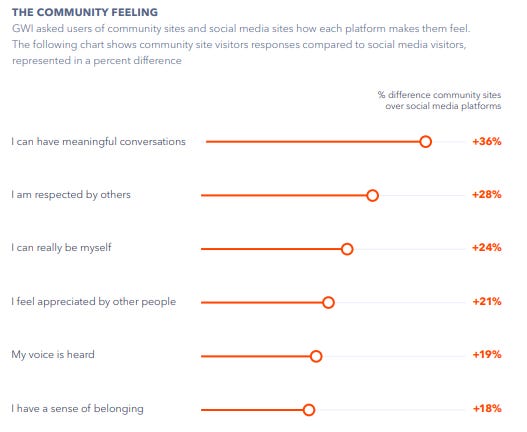
This is because social media is no more a trusted source of information and news. The biggest outright issue users identified with social media was the prevalence of misinformation, or “fake news”. Fake news is just the tip of an iceberg that looms into view when looking at how users view social media – that of trust.
On the other hand community platforms, with hubs geared to connect people around more common interests, and often with tighter controls around who can participate in discussions, allow their users to feel more self-confident, more validated, and less intimidated.
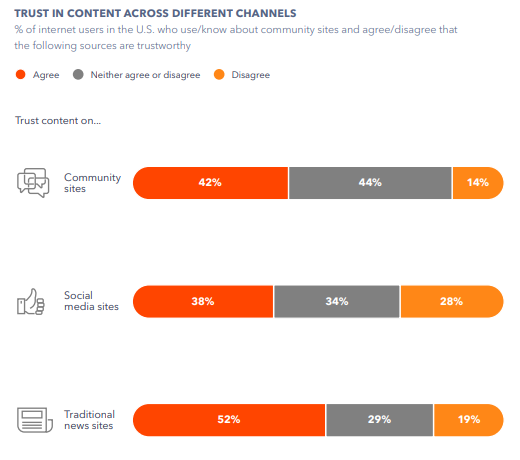
These findings are from the report “The era of We” by Reddit and Global Web Index.
Communities are built over the years. You should check out the Community page of Digital Ocean to understand the scale at which the American cloud infrastructure provider operates when it comes to community. The community section has a forum for developers, ways to get involved, and a blog.
Mastercard has been doing the same with its developer community. So does Oneplus for its developer community. The T series that it launches during this time of the year generally have better features and tweaked designs, based on customer feedback and also simply to stay relevant till the next generation arrives.
Community forums have become synonymous with trust, authenticity, and some of the most genuine personal interactions in the digital space. According to the Reddit report: 82% of community site users would be receptive to brands participating on these sites.
Since 2015, consumers have become keener to advocate brands that make them feel involved or let them feel like they’re in a one-to-one relationship.
Having a high-quality product or service will never go out of fashion. Along with it being relevant, one to one relationships and trust all play an important role in branded communities.
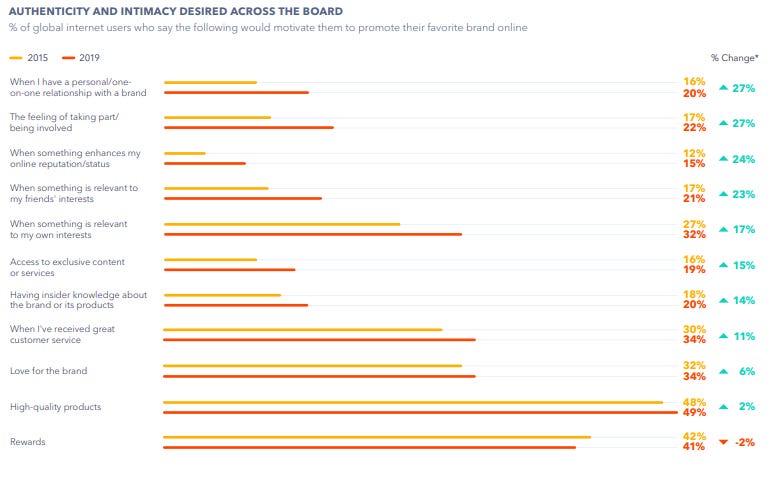
Content plays a leading role in building a community and it also is the biggest challenge. According to the Community Trends Report 2020, engaging with community members on an ongoing basis is the biggest frustration along with qualifying the value and automation.
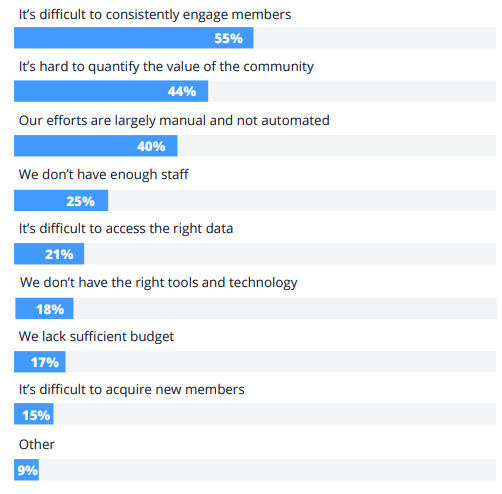
The frustration is bigger when you are building your community in the initial years. The 90-9-1 rule applies where the 90% would be lurkers and the brand or the creator of the community has to invest or create content rigorously. This could last for the initial few years. There are very few brands that have patience and hence the majority of communities die in the first few years.
With a weekend with me and a lot of time to think, I came up with a simple and no brainer Digital Community Framework.
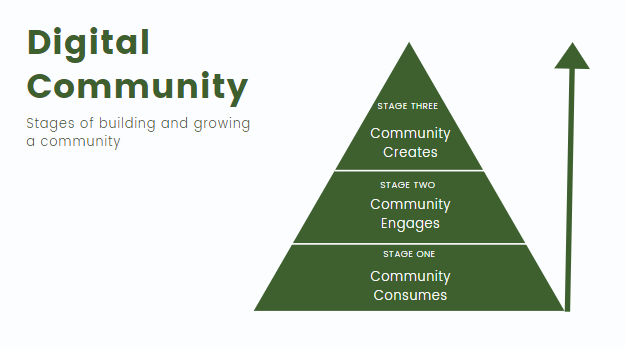
It isn’t rocket science. In the first few years, the brand will have to be the content creator and the users will be just passive consumers. Over the years when you keep adding value continuously then you will see a small percentage of users start engaging with you. And finally, there comes a time after years when the brand is no more controlling the community. Fans or supporters of the community become the advocates and keepers of the community.
A dream for every brand but only a few can achieve it. Meanwhile, you can ignore the framework word it was just an act of boosting my ego 😜😝.
The laws of community apply to nonprofit and for-profit organizations. So before you jump into the community madness make sure you have digested the challenges associated with.
Now let me get back to my latest Netflix series - The Queen’s Gambit. The mini-series explores the life of an orphan chess prodigy named Beth Harmon from the age of eight to twenty-two, as she struggles with addiction in a quest to become a grandmaster in chess
Have fun,
PN ♥️



